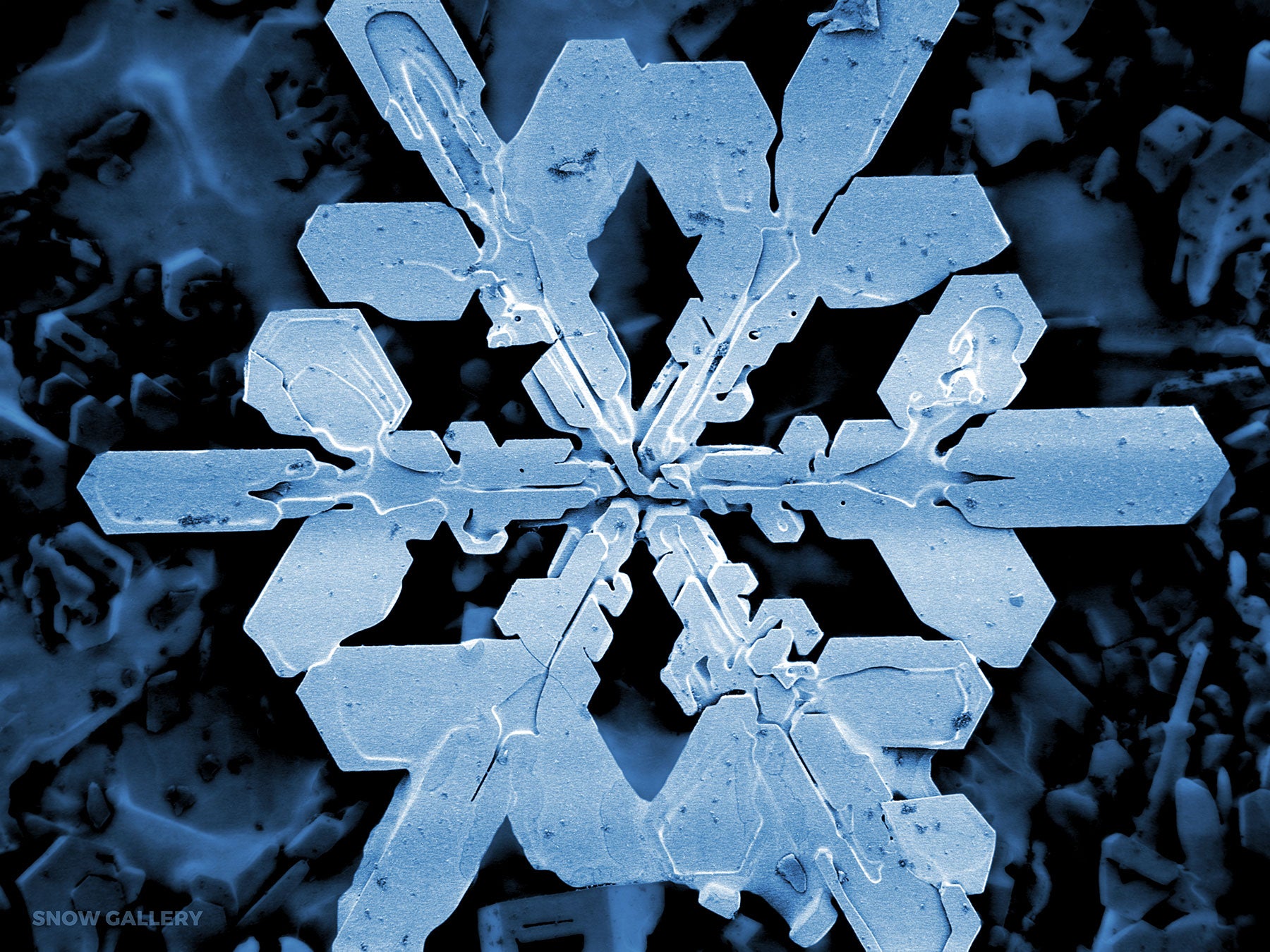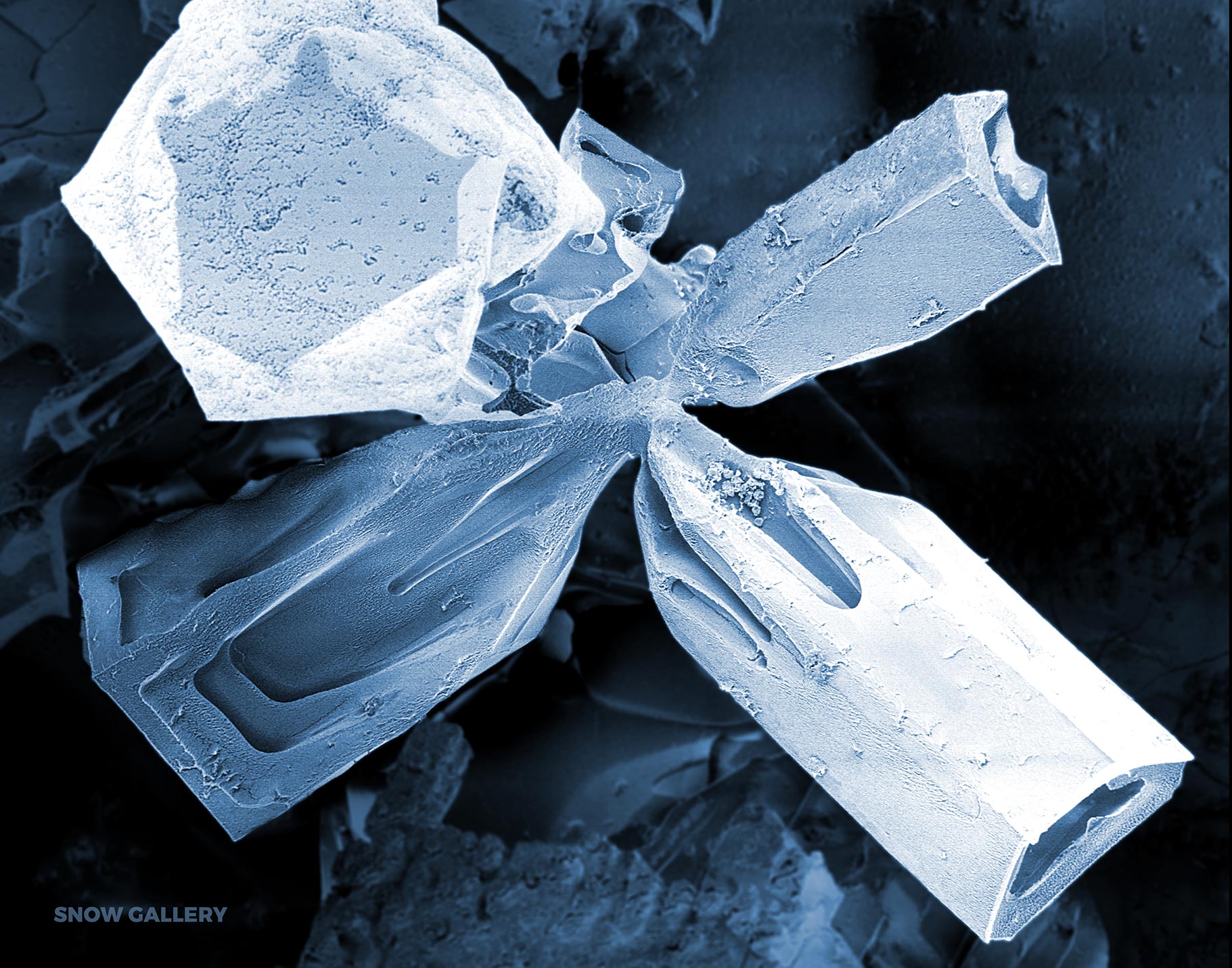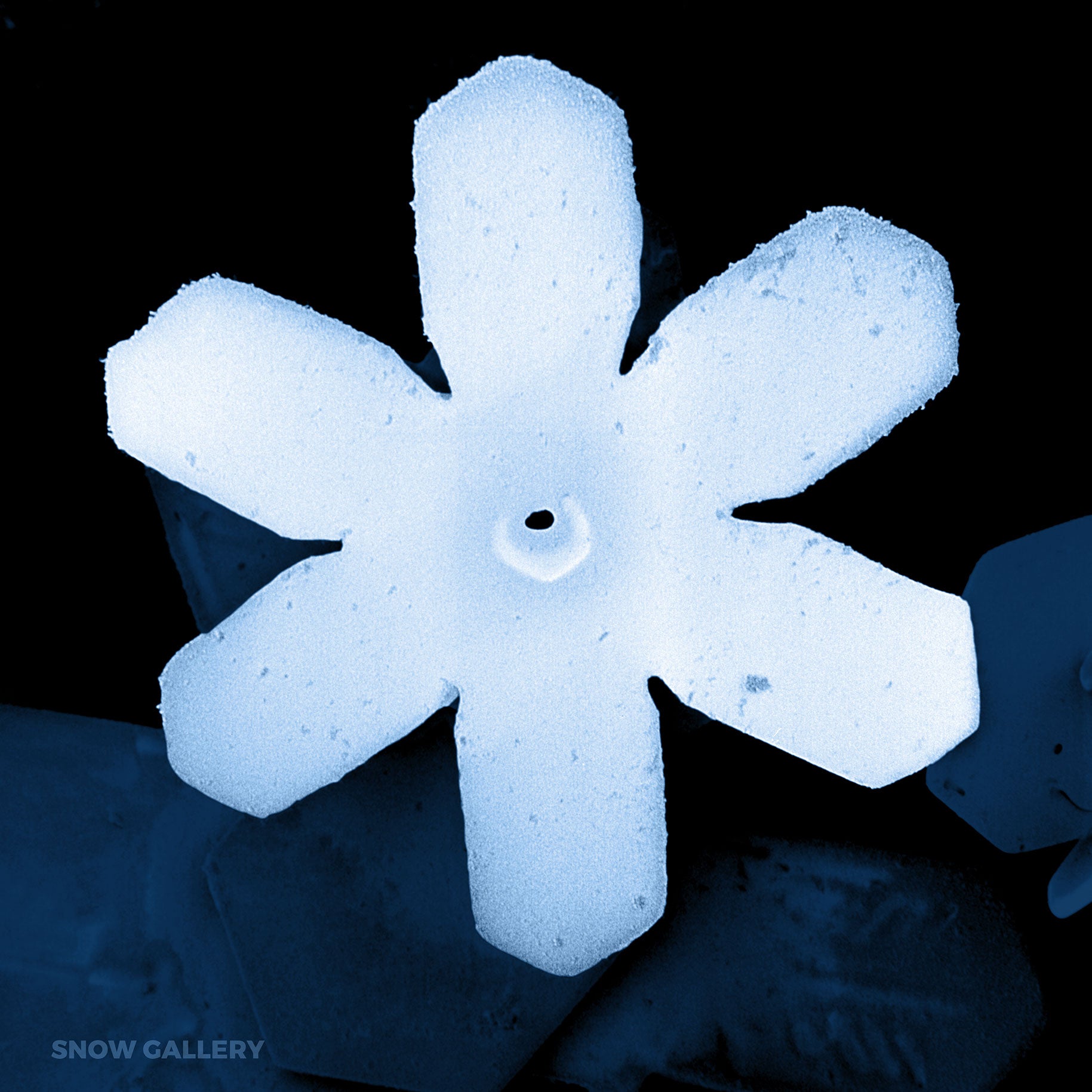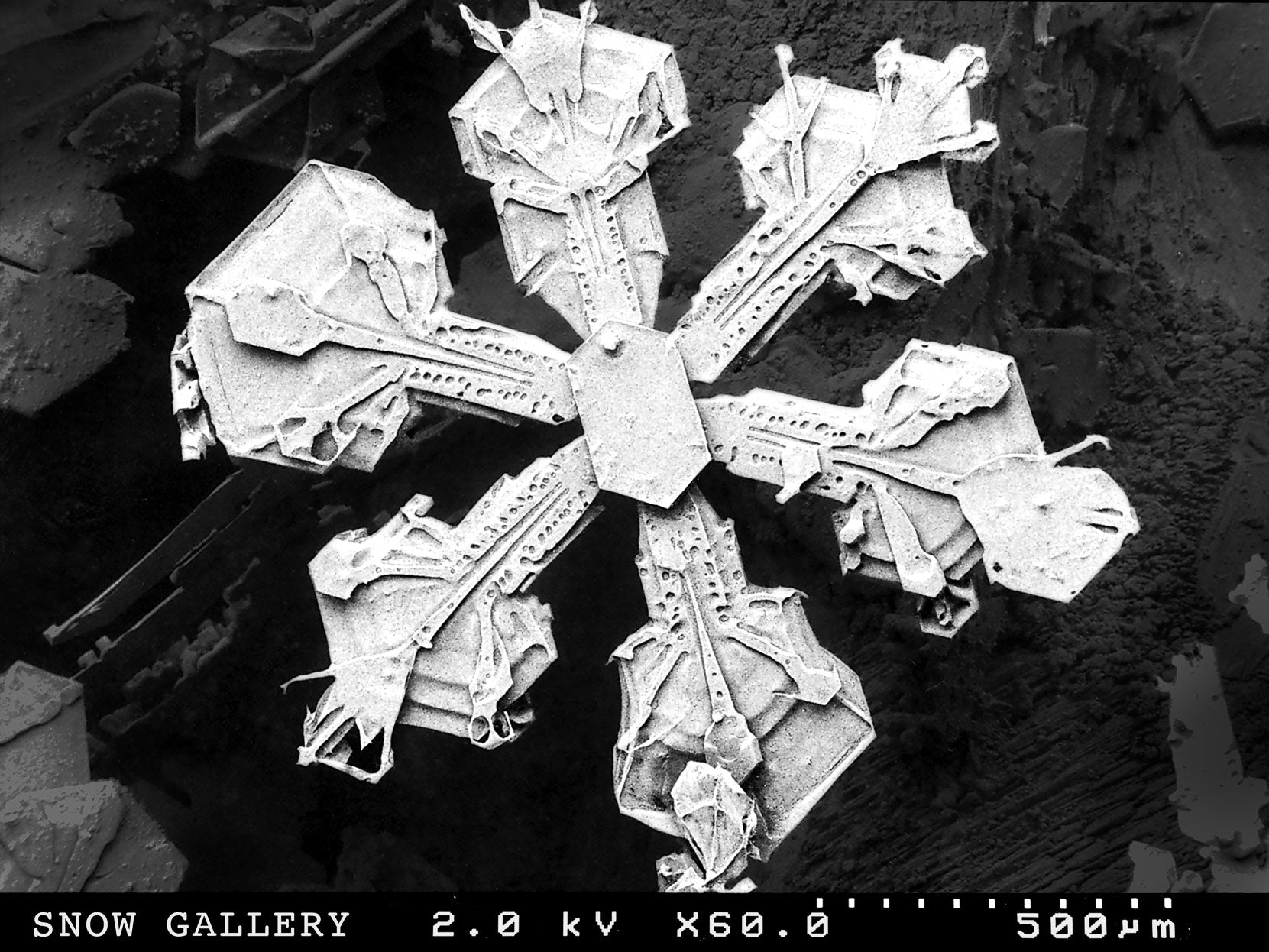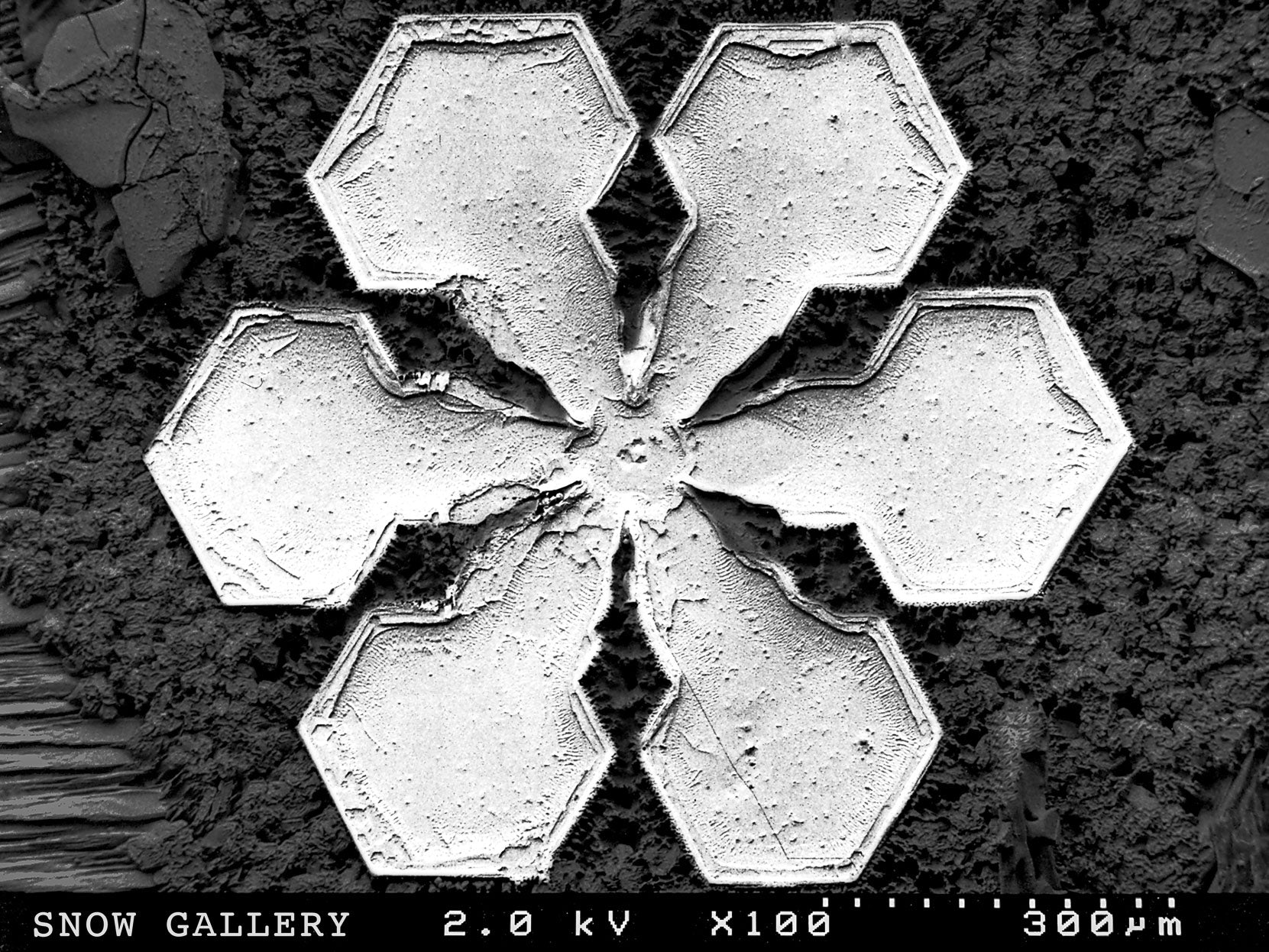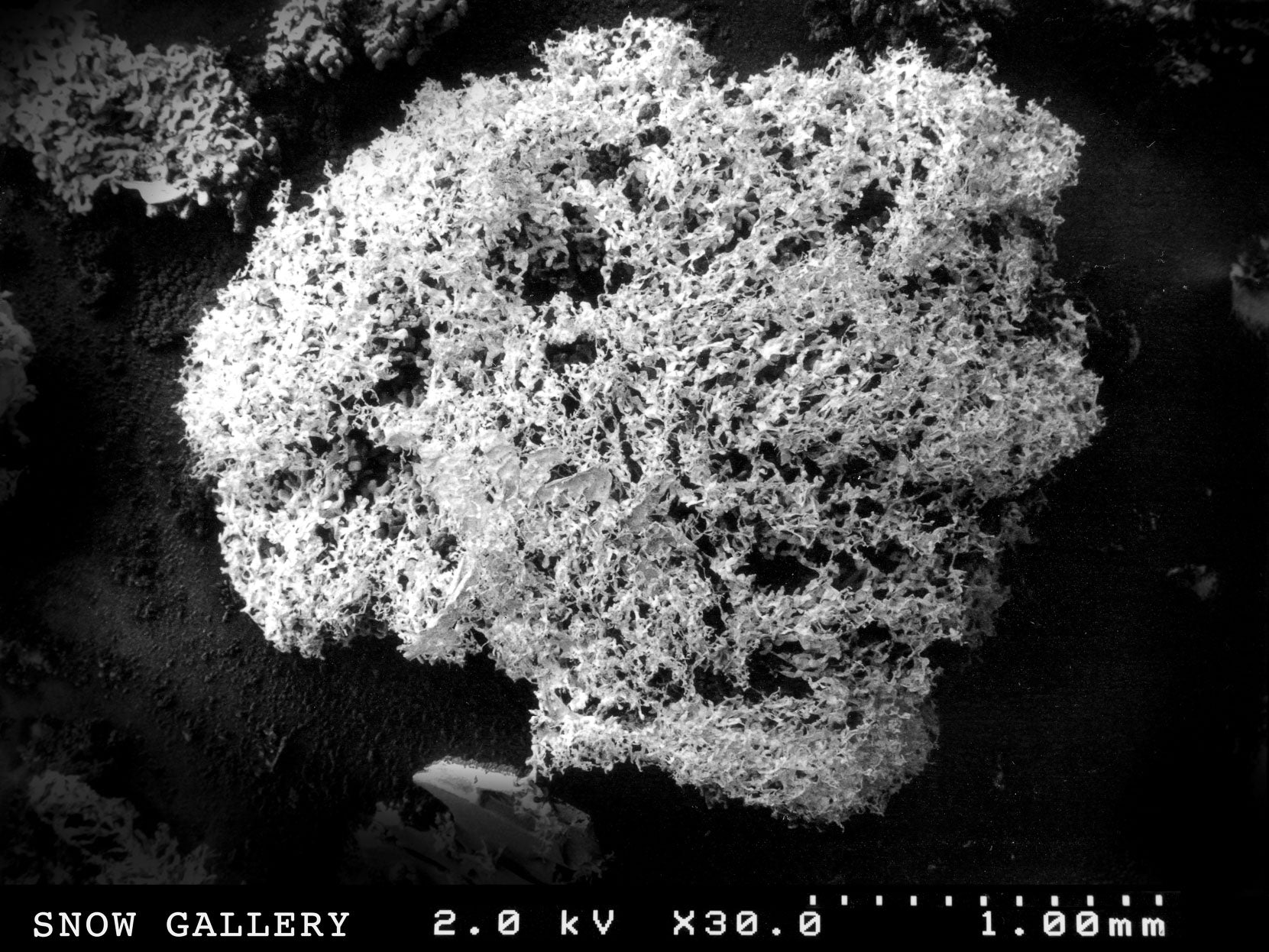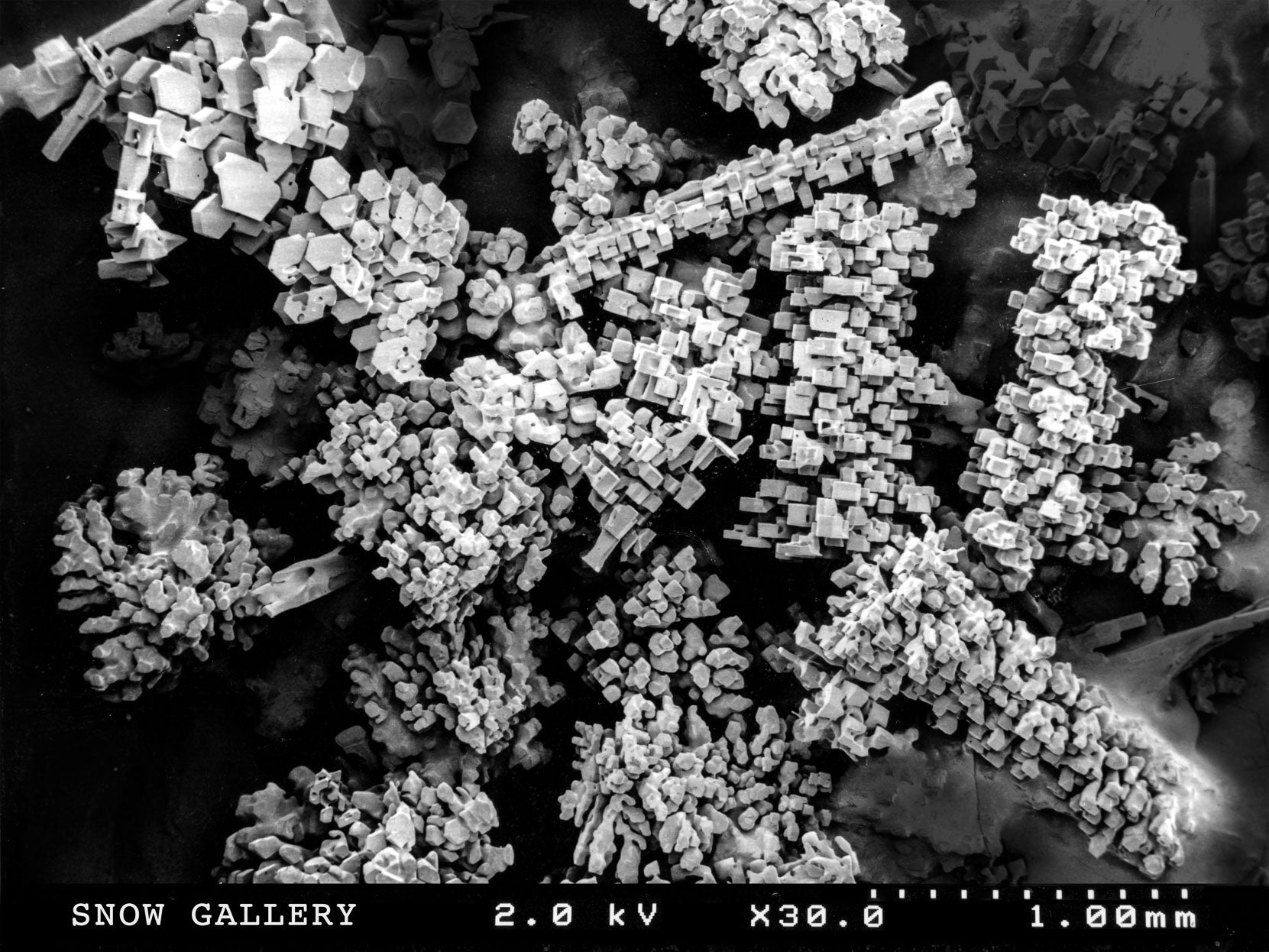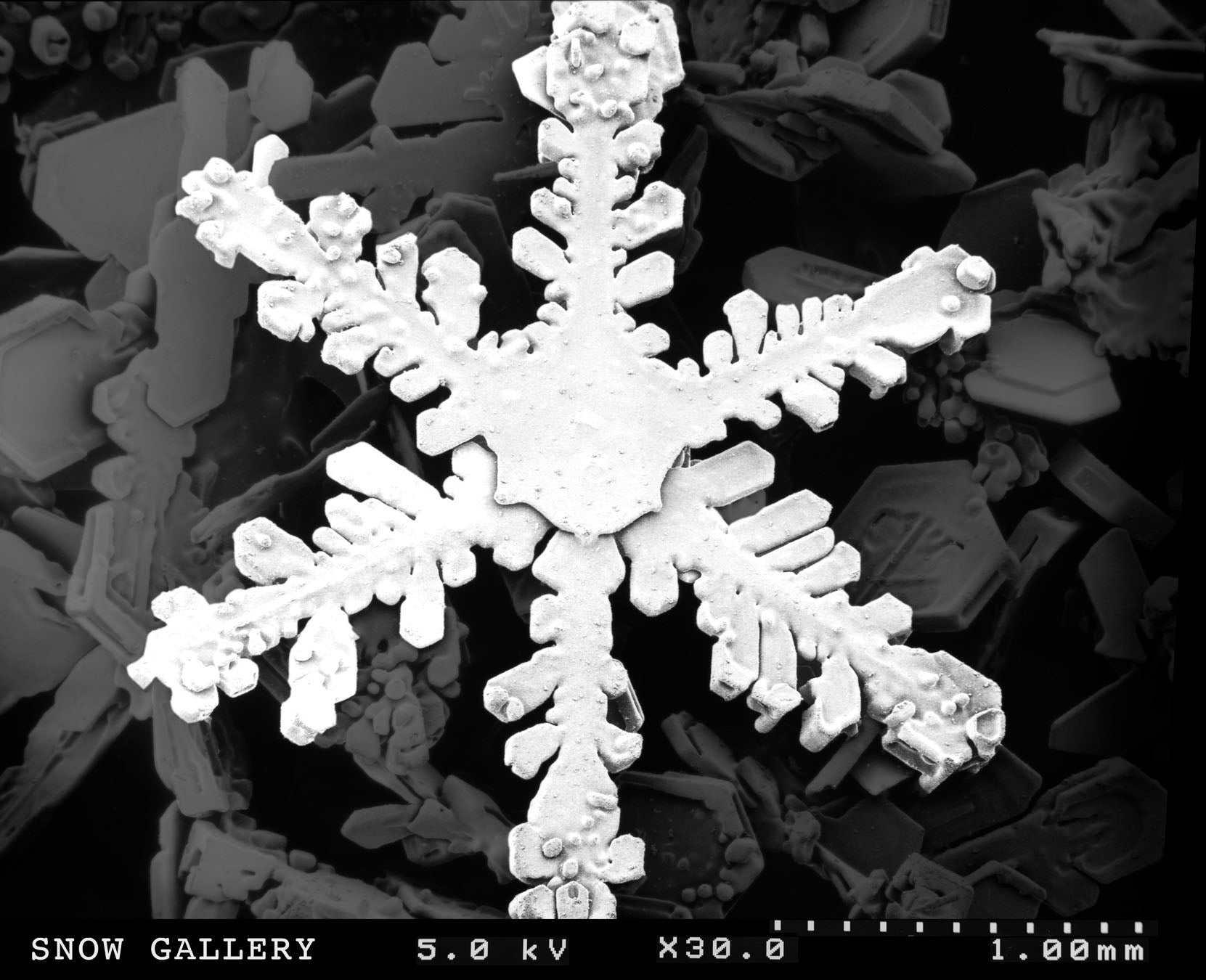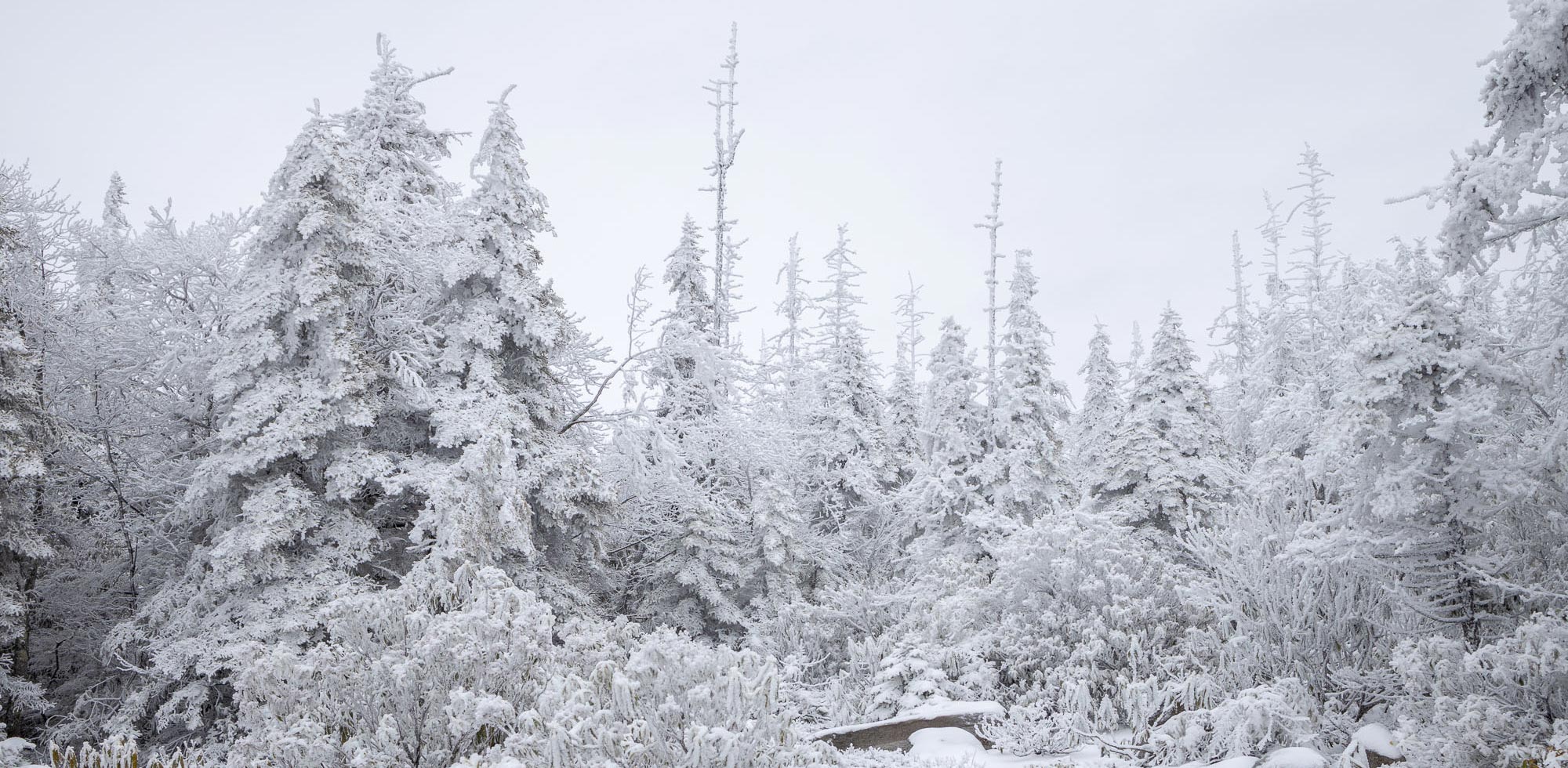I met Eric on the icy banks of Lake Placid, New York. I was working for NASA as a science media producer and videographer, and Eric was leading the microscopy unit at USDA in Beltsville, Maryland. We were all there to help teachers learn more about winter. Some had never seen snow! I found there was only one thing more fascinating than Eric’s snow crystal images mounted to huge display boards accompanied by his 3D-slideshow presentation about them—his striking blue eyes.
THE ROMANCE OF SNOW
Eric somehow managed to captivate everyone when he spoke about snow. In general, his enthusiasm took what might seem mundane and transformed it into something magical. He did not see profession or education when he conversed with someone about a complex topic; he saw a curious person with whom he could share knowledge. In addition to his lectures, that week at Lake Placid he helped dig snow pits, build snow shelters, and demonstrate the wonders of liquid nitrogen. He also rounded up enough cross country skis to take some of us on a moon-lit adventure.
One snowy evening as we strolled around the town of Lake Placid and Mirror Lake, he explained to me what a 46er was: someone who has summited all of the Adirondacks’ 46 peaks over 4,000 feet. The names and elevation of each of the High Peaks were engraved in pavers on the sidewalk, and he had climbed all but a few. I had no idea that this was just the tip of the iceberg when it came to his accomplishments as an outdoor adventurer.
As we made our way back, the snow picked up. Perfect stellar dendrites, grouped into huge flakes, were landing on the stark black of his coat. We didn't even need a loupe to pick out the crystals on his outstretched arm. Standing under a street lamp, he suggested I look up and pick out a snowflake…follow it to the ground. Again. It was mesmerizing. It was as if we had the power to slow time. Turns out, that night was Valentine's Day Eve.
We were married on the shores of St. John in the U.S. Virgin Islands. It was my first trip to the Caribbean, and as a child of the eastern seaboard, I really did think it was paradise. The day was full of great adventures and fabulous meals, all kicked off by getting hitched to my soulmate. Cliches exist for a reason: it was the happiest day I can remember.
THE NASA GIG
Eric retired a few years later, and I was at the top of my game at NASA. My work had taken me all over the world, and cold regions were becoming a theme—with the Geographic North Pole capping it off. I was no stranger to videoing in the snow, numb fingers were OK, it was frozen tripod fluid and camera lenses that bedeviled me.
I was afforded the opportunity to work with a small, tight-knit team to create NASA’s first film for Science on a Sphere—a resounding hit in the museum space. We ultimately developed a methodology and language for spherical filmmaking, leading to many additional film productions. My work-related travels slowed at this point, but I relished working with some of the world’s leading earth scientists, together, helping educate the public about climate change.
Now, with Eric, there was more to my life than work. Eric loved the outdoors and while I appreciated nature, it had been a while since I had really immersed myself. Workaholic? Maybe. But Eric got me back out there; hiking, biking, skiing, boating–all the activities he loved and at which he was so proficient. We loved our yearly pilgrimages out west each year to hike, ride and explore the desert; yet were always called back home to West Virginia and the lush, drippy forests surrounding our mountain cabin. Living in Maryland, our West Virginia get-away soon began to feel more like home than the sprawling pile of bricks back in the city.
So I quit NASA (really, who does that?) and moved to Canaan Mountain, just outside the small town of Davis, West Virginia. I’d reinvented myself at least twice in my life, so the fear of change was present but not paralyzing. I started a small business, Verglas Media, and grew it into something sustainable, helping many community members and businesses along the way. Eric spent his days working on trails, fixing up the house and making the yard look like a park, albeit one full of technical and somewhat sketchy mountain bike features. During this phase of our lives, we had four amazing, beautiful years.
PARADISE LOST
In late 2016 we learned that his growing list of aches, nagging cough and pale skin had a vicious name: Leukemia. Acute Myeloid to be specific, and there’s currently only one known cure: a bone marrow transplant accompanied by chemo, radiation and pills, pills and more pills. So he did it. All of it. Hospital stays and visits I lost count of. My years as a video producer and business owner had prepared me—well somewhat—for this: charts, lists, alarms, no sleep. To our great joy, Eric came out of it! He was the poster child for bone marrow transplant recovery leaving that hospital behind sooner than most of his peers: I remember almost feeling guilty.
He got better and we traveled out west again. Back home, he furiously created and repaired trails, and got back on his bike and lawn mower. We returned to cabin life; the cancer life receded like a now-past nightmare. But the AML apparently intended to stay away only long enough to lure us back into happiness. In December of 2018, he was back in the hospital fighting for his life—but there was hope: A new treatment had been approved. The cancer and chemo battled it out in his blood and I was vigilant alongside him. He survived, again!
Only this time the arc of recovery folded back on itself. While his new drug had seemingly defeated his cancer, now his knees began to tremble and his daily hiking regime became a chore. Turns out, the drug had a rare, devastating side effect: Guillain-Barre Syndrome. It was not long before my beloved outdoor-adventuring husband was in a wheelchair, paralyzed from the waist down. The miracle drug got pushed aside—we were now on the front lines of fighting GBS. My skills as a war nurse had to level up.
There was hope: By September of 2019, Eric was taking his first steps in six months with the help of three people and two parallel bars. We were operating on nothing but hope, but it seemed to be working. However, with treatment options exhausted, the leukemia returned: it had gone unchallenged for too long. A few months later, on the snowy morning of January 20, 2020, I lost him. After he took his final breath, I said— with great irony— “Say hello to Carl Sagan for me.” I was still operating on hope. Anything is possible, right? “You can’t prove a negative,” was something Eric used to say when discussing aliens, god or the hereafter.
THE TRIBUTE
That first night I couldn’t sleep, the blowing snow outside the window was so intense and lyrical that I imagined it was Eric, hanging around to make certain I was going to survive before he left on his trip to check out the universe. It snowed every day that week, and it was the best winter our area had in years. Who knows, anything is possible. Can’t prove a negative.
Snow had always been central to our love story, and it had been something Eric had studied closely. Among his accomplishments at USDA was the technique he developed to collect, store and image snow at high magnification with startling clarity. Hydrologists saw scientific data and information, I saw art, his snow crystal work being a captivating blend of literal abstraction. I recently wrote story for the Highland Outdoors Magazine which fully covers the story of how theses snow crystals came to be.
All electron microscope images are initially black and white. Eric and I talked at length about how to best color them; he felt shades of blue was the only way. Early on he encouraged me to print some postcards. Later as we traveled to art galleries around the country he mused about how large, glossy snow crystal prints should be on their walls.
Holding a Snow Gallery print in your hands, I hope you feel the same reverence I do. Each snow crystal has lived its own adventure with a story to tell, if we will but choose to listen. And now it will live the remainder of its existence on your wall, preserved by the highest quality paper, archival inks and mounting substrates.
___
Victoria Weeks
Founder | Snow Gallery
